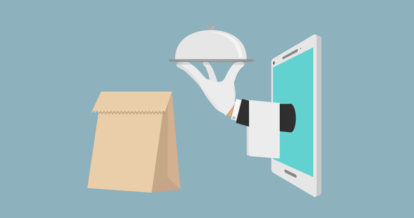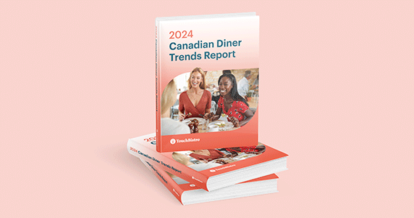You might think a takeout app isn’t worth the operational hassle or extra pressure on the kitchen – but consider how much the restaurant industry has shifted to depending on takeout and delivery the last few months. Knowing the best food delivery apps is a key part of restaurant success right now – and until dining rooms are back at full capacity.
In this article, we’ll go over:
- How takeout and delivery has evolved and continues to increase in popularity
- The difference between takeout and delivery apps
- The best food delivery apps and takeout food services
- What these changes mean for restaurants
Let’s dive in.
The Evolution of Takeout and Delivery
Pre-smartphone, the solution to hunger at home was to call the closest place that offered delivery, provide an address, and wait for the on-staff driver to get through their existing drop-offs, before getting to your order – and hope they didn’t get lost. If the customer lived outside the delivery radius, or the local venues didn’t offer delivery – too bad. Restaurants had to set up their own delivery system, meaning the options were limited and the wait times were long.
The new breed of food delivery apps present endless options to customers with a couple of swipes and the tap of a button. Everything from gourmet food, healthy fare, and trendy snacks to classic burgers and international cuisines are literally at the tip of your finger. Whatever the craving, there’s an app that gives customers access to it.
Food delivery apps were already rising in popularity, but COVID-19 pushed them to become the cornerstone for many restaurant operations. Restaurants that had to close their dining rooms turned to a takeout and delivery-only model, making their online ordering system even more important. Even as dining rooms reopen, limited capacity and shifted business models mean diners and restaurant owners alike are still relying heavily on food takeout and delivery services.
In fact, the probability of Americans ordering takeout or delivery rose during the lockdown periods. Over 40% of Americans said they were highly likely to order from restaurants during their lockdown, with another nearly 30% saying they were somewhat likely.
So what are these takeout delivery apps and how do they work?
Let’s explore.
Take Out Apps
If you want a better understanding of how these different apps work – and which ones will work best for your restaurant – start with the difference between takeout and delivery apps.
A third-party takeout app is a mobile or desktop application that accepts to-go orders, letting customers skip lines completely and only arrive when their order is ready. They walk in and let the restaurant or business know they’ve arrived, get your food, and head right out. Easy!
Take Toronto’s Ritual takeout app, which is now also operating in Chicago, New York, L.A., and Boston, due to their overwhelming popularity with busy urbanites. The user searches a list of possible restaurants within walking distance and chooses a menu item. Using geo-location and estimated travel time, the customer is prompted when it’s time to leave, so they’ll arrive right when their order is up.
By using takeout apps, restaurants don’t have to worry about long lines (especially important since we are still encouraged to stay six feet apart and avoid crowds!), customer disappointment from out-of-stock menu items (“I wouldn’t have come if I knew you were out of cheesy buns!), or having counter staff enter orders incorrectly (“I thought you said EXTRA whip.”). You and your staff can just focus on processing a higher volume of orders and preparing delicious food, as efficiently as possible.
Plus, these apps can often be integrated right into your POS (versus having an extra third-party tablet – or 10 – on your counter to manage orders). This way, orders are streamlined into your system, with no need for your staff to manually enter them into the POS.
Delivery Apps
On the other hand, a third-party delivery app is a mobile or desktop application that accepts delivery orders and connects with an available driver to drop off a customer’s food at the requested location. No pick-up required.
With a third-party delivery app like Uber Eats or DoorDash, the whole experience is curated by that company: from the order experience to the driver to the delivery – you receive the order from them and prepare it.
Your POS can also integrate with delivery apps, so you get notified when a new order comes in and can manage third-party drivers all from one system.
But one of the biggest perks of these apps?
Both third-party takeout and delivery apps also work as a marketplace, a way for customers to discover new restaurants. Think of them as an online food hall – diners can see all their nearby options in one place, scroll through, and select where they want to order from. If you’re looking for new methods of how to market your restaurant and reach new audiences, these apps are a great way to gain exposure and get new eyes on your business.
Third-Party Online Ordering Apps vs. In-House Systems
From Uber Eats’ delivery drivers to DoorDash’s anything goes (car, motorcycles, scooters, bikes, even walking is accepted), these third-party online ordering apps create a system of independent contractors that criss-cross cities to pick up orders from hundreds of restaurants and deliver to eager eaters every day.
With so many options, it’s easy to find a delivery app in your area. Just remember, they’re not always the most cost-effective method. Especially during the pandemic, these apps have taken a lot of heat for their hefty commission fees (up to 30% per order!).
As a result, more businesses are taking ownership over their restaurant online ordering system, setting up direct or in-house system instead (e.g. TouchBistro Online Ordering. This lets restaurants stay in control of the end-to-end experience for customers AND keep more profit in their pocket.
In-house online ordering software lets restaurants take orders directly on their own website, marketplace (like order.tbdine.com), or over the phone/in-person. The customer then picks up the order at the restaurant, or the restaurant opts for delivery, organizing their own fleet or working with a local restaurant delivery service.
What’s the Best Online Ordering & Delivery Solution for Your Business?
Top 6 Food Delivery Apps and Takeout Services
If you decide that food delivery or takeout apps are the right choice for you (either exclusively or in addition to an in-house system), research the best apps for your business, in your area.
Consider factors like price, delivery range, and commission fees, as well as local popularity.
To help you get started, here are some of the highlights of the best food delivery apps and takeout services available now.
1. DoorDash
Services: Delivery
Where: Available in major U.S. cities, Toronto, and Vancouver, Canada. DoorDash is used by 54,000 restaurants.
Differentiator: DoorDash operates primarily in suburbs, as opposed to just the city centers that are more common with other delivery apps. They are also one of the only apps to not prohibit restaurants from charging lower prices for ordering direct or on other channels – a big win for restaurants. Why? It means you could increase prices on that platform to offset the delivery app’s commission fees, without increasing the in-house restaurant list price.
2. GrubHub/Seamless
Services: Pick-up and delivery
Where: Available in 4,000 U.S. cities (with a strong presence in New York), some major Canadian cities, as well as London, U.K. GrubHub is used by over 300,000 restaurants.
Differentiator: Seamless typically caters to a more professional audience, while Grubhub is for the “every person,” including students. Seamless was bought by GrubHub in 2013, which was then acquired by British online food order and delivery service Just Eat in 2020.
3. Postmates
Services: Delivery
Where: Available across major U.S. cities, as well as some Canadian cities. They are used by over 500,000 restaurants, grocery, and convenience stores, and even some traditional retailers.
Differentiator: They don’t just deliver food. Customers can order sushi from their favorite spot, a pair of headphones from Best Buy, or their favorite lipstick from Sephora. In 2020, Postmates was acquired by Uber Eats.
4. Uber Eats
Services: Delivery
Where: Available in major cities across North America, South America, and Moscow, Russia.
Differentiator: Faster delivery, boasting an average of 15 minutes. This is probably due to them having the largest fleet of delivery drivers, due to their system being built on the infrastructure of the rideshare app.
5. Caviar
Services: Pick-up, delivery, and catering
Where: Available across major U.S. cities including Brooklyn, Boston, Chicago, Dallas, Manhattan, Los Angeles, Philadelphia, Queens, Sacramento, the San Francisco Bay Area, Seattle, Portland, and Washington D.C.
Differentiator: The Cadillac of food delivery! Caviar, acquired by DoorDash in 2019, delivers food from higher-end restaurants. Many of the restaurants on Caviar offer delivery exclusively through this platform and nowhere else.
6. SkipTheDishes
Services: Delivery
Where: Available across Canada.
Differentiator: With roots in the Canadian prairies, SkipTheDishes was also acquired by Just Eats in 2016 and is the largest food delivery network in Canada, partnering with restaurants in more cities than most north-of-the-border apps.
Takeout and delivery apps may differ slightly in their approach, but the underlying principle is to get great food to hungry customers.
Delivery-Only Restaurants
Delivery-only restaurants, or ghost kitchens, are also a huge part of the takeout and delivery movement. The idea of a ghost kitchen is a space that is created solely for filling takeout and delivery orders and can be found on a website or third-party app. This means no seating area, packed tables, or front of house team.
And this business model has a lot of perks – especially throughout the pandemic. With so few people having to come in, there’s less chance of spreading germs, less money on rent for a larger space when only the kitchen is in use, and additional outbreaks won’t disrupt your business model.
In fact, while restaurants across the country had to lay off staff and shutter doors, ghost kitchens had to actually hire thousands to meet demand. Take C3 for example, a food hall and, that had to hire over 1,000 new employees to meet their doubled demand.
What This Means for Restaurateurs
The experience of takeout and delivery has changed for everyone involved. Diners can use a handful of different apps and enter a virtual marketplace of their choosing, with curated lists of restaurants just waiting for their order.
For restaurants on the other hand, the increase in choices available can seem overwhelming. You have to decide which apps will work for your restaurant, how many you should use, and how to offset the commission fees.
To help with these decisions, there are some major factors you’ll want to consider:
- Reach: Can this app help put your restaurant on the map? How many people are using it? The more eyes you can get on your restaurant, the better. Though the data is pre-pandemic, check out Restaurant Business’ look at which app is most popular in which major U.S. city.
- Cost: How much does this cost every month to be on a third-party app? Does it balance out with the number of customers you’re reaching? Is it more cost effective to take the whole operation in-house? As we touched on briefly before, many third-party apps have seen major backlash for their costs lately, especially as restaurant owners struggle with even smaller profit margins during the pandemic. Some of their pricing tactics during this time have been called “predatory,” and restaurants have asked diners to order direct instead. Having the logistics completely taken care of by third-party aggregators can be extremely appealing, but you have to carefully weigh out the costs associated.
- Local Laws: These are updated constantly, especially with how fast COVID-19 seems to change, but you’ll want to consider local laws with any business decisions. Are reopenings and closures happening frequently in your city or state? Would investing in the best food delivery service in your area help you keep running, regardless of dining room restrictions?
You’ll want to take these factors into consideration when deciding on if a takeout or delivery app is right for you, and which one you want to go with.
Takeout and delivery apps are here to stay, especially as restaurants continue to struggle with restrictions on their capacity and overall operations. By leveraging the best apps in your area, you can increase your restaurant’s visibility and overall sales, without relying (as heavily) on dine-in.
To maximize your presence on these apps, be sure to optimize your menu options for easy portability and quick delivery (think watertight soup containers and spill-proof food packaging), and upload great photos that present your food in a realistic, yet mouthwatering way.
Free online ordering signs for your restaurant







